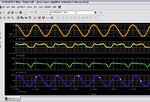goldsmith
Advanced Member level 6
- Joined
- Dec 14, 2010
- Messages
- 3,981
- Helped
- 741
- Reputation
- 1,486
- Reaction score
- 726
- Trophy points
- 1,413
- Location
- Tehran - IRAN
- Activity points
- 24,546
Dear LvW
Thank you very much for your reply .
It's efficiency is good . and it's operation point is ok ( the base has a little negative bias , that provided by input capacitor and negative half cycle and the inductor ). ( as i know .)
So what appear that circuit in your idea ? i guess that you have doubt about it's operation ? isn't it ?
Respectfully
Goldsmith
Thank you very much for your reply .
It's efficiency is good . and it's operation point is ok ( the base has a little negative bias , that provided by input capacitor and negative half cycle and the inductor ). ( as i know .)
So what appear that circuit in your idea ? i guess that you have doubt about it's operation ? isn't it ?
Respectfully
Goldsmith

